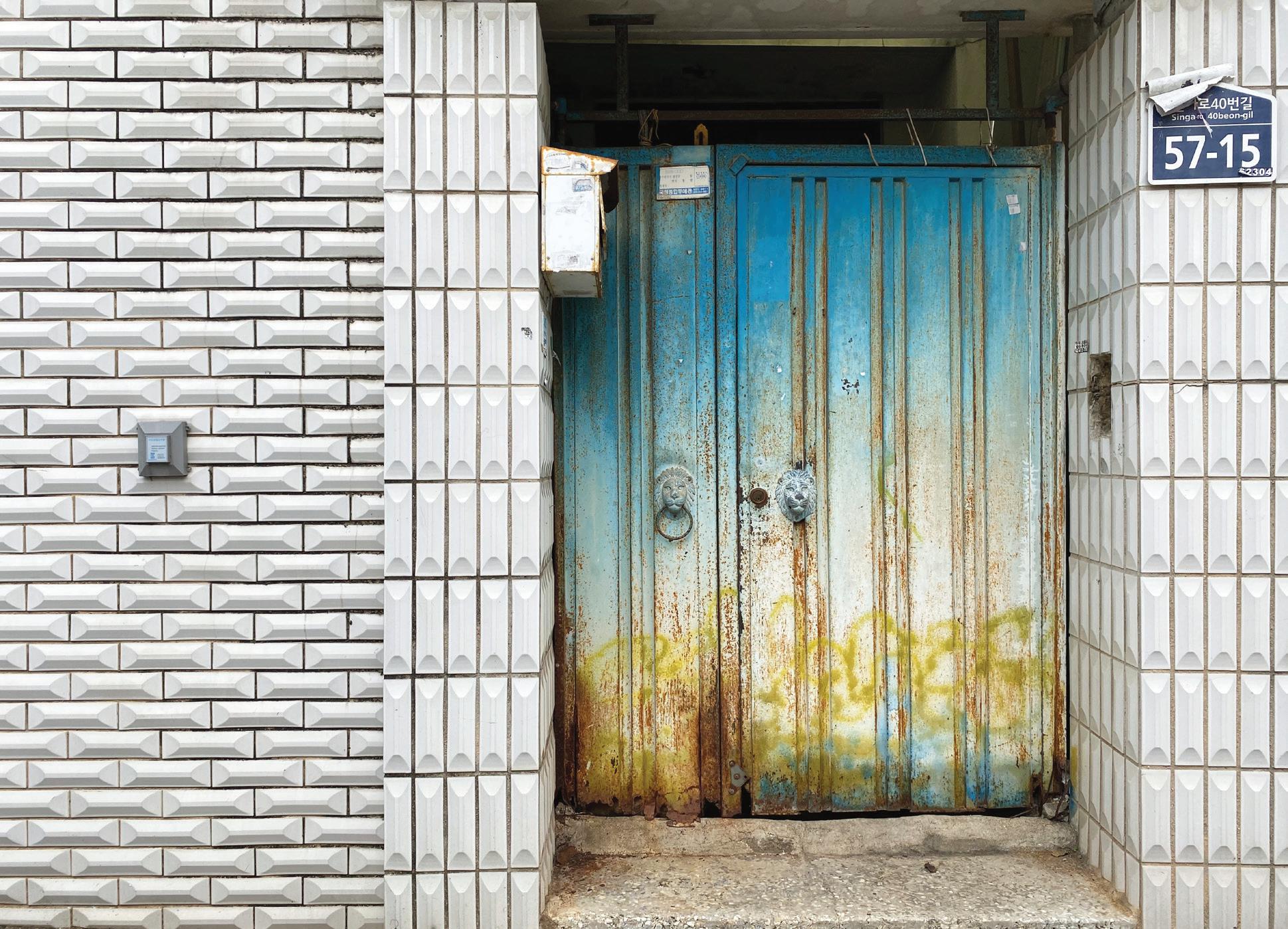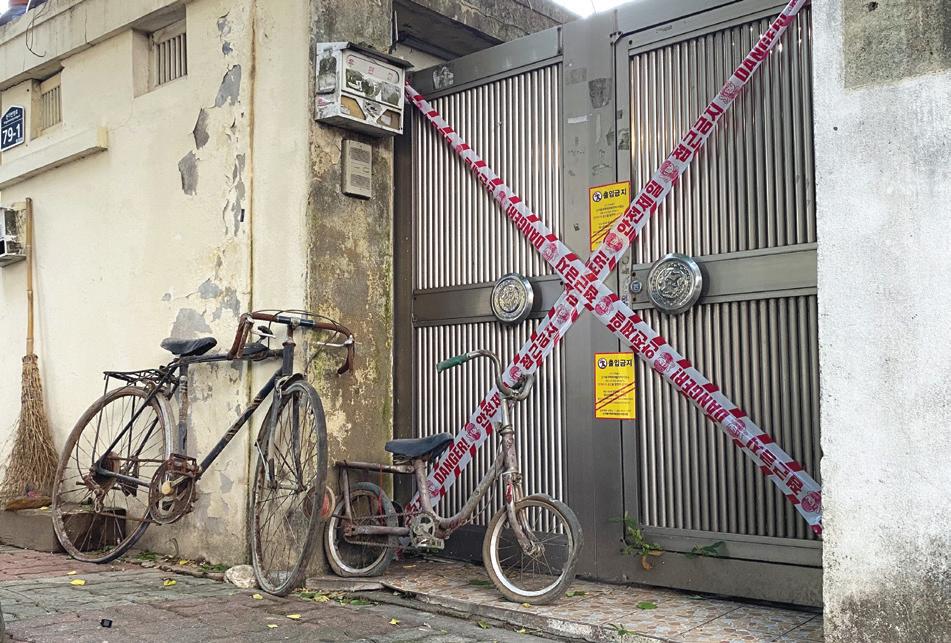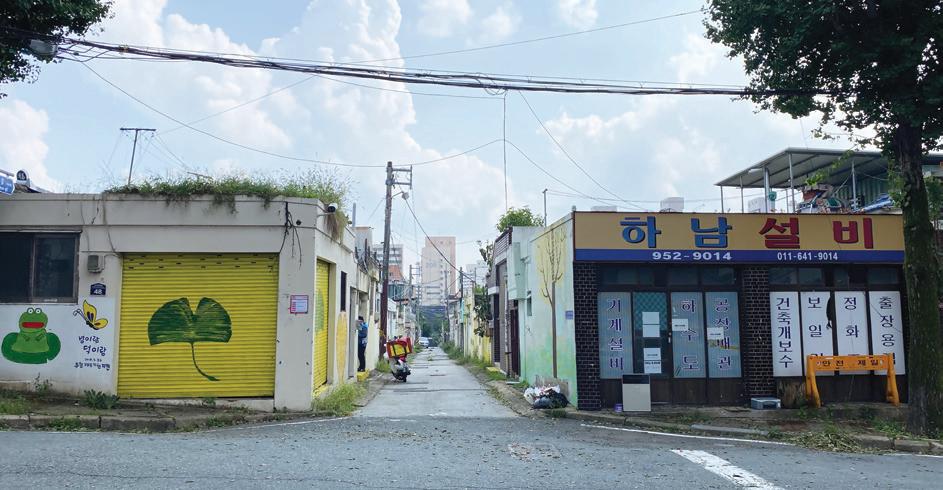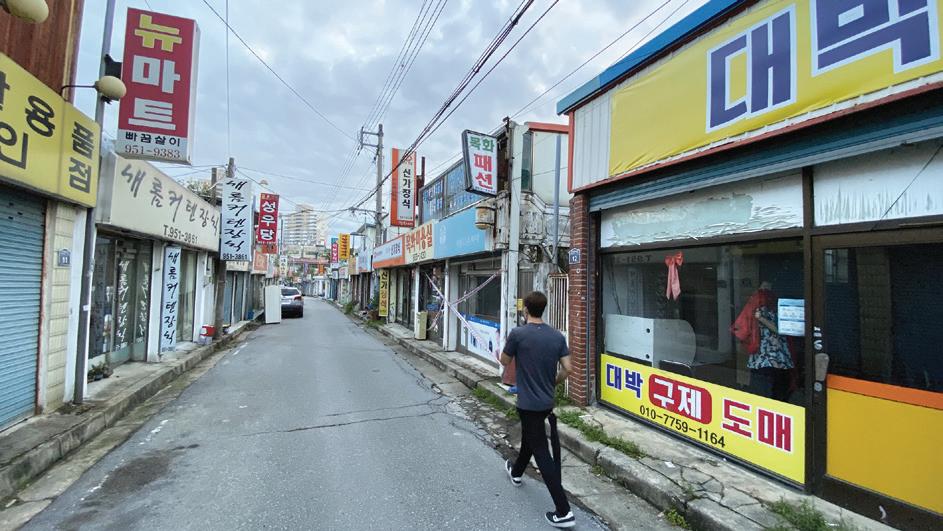
9 minute read
Lost in Gwangju: Singa-dong Gives


Advertisement
Singa-dong Gives Up the Ghost
Written and photographed by Isaiah Winters
Th e entrance to a home not yet vacated.
For Gwangju’s up-and-coming striver class, buying a new apartment in the affl uent Suwan District is the quintessence of “making it.” Th is monied district is young, modern, and lacking in little – save character. Th at’s why those who “make it” to Suwan immediately fl ee to trendier neighborhoods whenever they have leisure time. Having lived out there myself for a few years, I know how real the weekend exodus to anywhere-butSuwan is.
Th e only redeeming neighborhood in the area is just south in Singa-dong. Th e neighborhood is a patchwork of commercial and residential units organized into grids with low, two- or three-story businesses lining the main arteries and jutaek houses hemming the tight back alleys. Quaint and quiet, these long, narrow alleyways are great to wander, especially where gentle bends splay out into little three- or four-way junctures bracketed by small corner stores. Th e community fi ts together so well that it feels both planned and organic – like a humble village in lattice formation. backstreets with row aft er row of aff ordable units, each with its own eclectic allure, all just a stone’s throw from a surfeit of young, suburban, upper-middle-class café addicts who are obliged to take 40-minute bus rides downtown to Dongmyeong-dong and Yangnim-dong for their latte and selfi e fi x. Meanwhile, Singa-dong is just a 15-minute walk from Suwan’s main drag – the same time it takes to walk from Th e First Alleyway to Dongmyeongdong. But now that Singa-dong is in the throes of eviction ahead of demolition, I guess neighboring Suwan is doomed to forever hemorrhage its hipsters on weekends.
A smattering of hipster joints might well have helped to revitalize the now condemned parts of Singa-dong, thereby keeping the wrecking crews at bay. Th is alternative to demolition – the boutique lobotomy – would of course come with problems of its own, though it would surely be better than bulldozing everything and salting the earth with more high-rise apartments. Th e latter will only result in more people moving to Suwan just to fl ee its marrowdeep inauthenticity at fi rst chance. Unfortunately, only aft er another decade of breakneck redevelopment will we likely realize how quickly we gave up scruff y, endearing vestiges like Singa-dong.
And scruff y it is. On my last visit, the doors to about half the units had already been wrapped in saltires of caution tape that acted as seals. In this way, any suspicious break in a seal could later be investigated via the nearest CCTV camera, of which there’s an ungodly number in the area. Echoing an Orwellian dystopia, it’s as if a camera stares you in the face at every other street corner, light post, and dead end. Th is network of livestreams creates an all-seeing panopticon intended to keep burglaries and littering down. I assume the property redevelopers meticulously set each camera up, though I can’t say for sure. Nevertheless, on my many visits, seals were frequently rebroken and garbage seemed to mount by the day, so whoever’s tasked with tracking down malefactors has his work cut out for him.
Lest you think the cameras are just for show, posters bearing CCTV stills of litterers in the area are almost as commonplace as the cameras themselves. According to the posters, those caught littering on foot face a 200,000–300,000 won fi ne, while those caught littering from vehicles face a steeper 500,000–1,000,000 won fi ne. Th e message throughout Singa-dong is clear: Th ese people are serious – far more serious than any I’ve seen in redevelopment zones elsewhere in our city.
Beyond these portents of Big Brother, there’s another, more traditional type of monitoring in the area that helps clamp down on sketchy activity: local senior citizens. Th ough I behaved myself on my many recent visits, I was oft en shadowed – and sometimes sharply questioned – by locals of a certain vintage for my photography. It must have looked highly suspicious: an oversized foreigner snapping photos of myriad alleys and abandoned entryways. Th e elderly who still have a stake in the community would sometimes stick around and make a little noise, thinking that would scare me off ; others studiously ignored me and gave me a wide berth, like we were two repelling magnets. With a hobby like this, you get used to it.
Despite going on repeated photo shoots in the area, I’m disappointed with how my pictures turned out. Some places are just more impressive in person, and Singadong may be one of them. Fortunately, where photos fail, there are words. Over the course of my repeat visits, I observed many details that were far more interesting as subjects of writing than photography. One that sticks out is an advertisement for the removal of yupum ( 유품), or articles left behind, oft en by the deceased. Th e ad showed four exemplary photos of disheveled home interiors left in the wake of the former residents. Now that’s a haunting job I’d like to tag along for.
▲ Caution tape in the form of St. Andrew’s Cross seals homes of evicted residents.


▲ Artwork and alleyways crisscross Singa-dong’s condemned ▼ neighborhood.

what hipsters crave, including the hipsters themselves; however, redevelopers got to it long before many noticed its value. I must admit, I only know of the area because I used to live across the street and would frequently roam its alleys on late-night walks, so it’s been on my radar for a long time. I’m sad to see it go and wish the locals the best, but Suwan – you just lost your soul.
The Author
Originally from Southern California, Isaiah Winters is a Gwangju-based urban explorer who enjoys writing about the City of Light’s lesser-known quarters. When he’s not roaming the streets and writing about his experiences, he’s usually working or fulfi lling his duties as the Gwangju News’ heavily caff einated chief proofreader.


The Philippines at Its Best!
Written by Carlota Smith
The Philippines is a haven for nature enthusiasts and adventure seekers alike. Th e Philippines’ 7,641 islands provide the best possible, if not simply downright perfect, experiences for an entire lifetime. Being home to almost 110,000,000 people from all walks of life, every location in the Philippines provides one with many choices of both fun and excitement.



From the sunny beaches to the steep hills and historical sites, one may be overwhelmed with nature’s generosity and abundance presented in the Philippines. Many foreign visitors and Filipinos themselves have already gone to see these famous and beautiful places. However, there are always many more exquisite, untouched, and enchanting places to explore. One of the most frequented destinations is Palawan. Palawan off ers tourists a wide array of choices for both aquatic adventures and relaxation. Other frequently visited destinations include Boracay, El Nido, and Coron – but this is just to name a few of the breathtaking places people can enjoy in the Philippines.



Th ose who thirst for various kinds of aquatic thrills will surely have their thirst quenched by any of the locations just mentioned. Mountain trekking and hiking enthusiasts will be amazed by the mountainous terrain that will provide them with a guaranteed exhilarating experience. From the gentle hills of Mt. Ulap in Benguet to the steep terrain of Mt. Pulag, hikers can simultaneously enjoy their scenic views and the relaxing breeze. Of course, Bohol in the Visayan region should not be missed, especially if you want to have a peek at the tarsiers, the nearly extinct primates you can fi nd there. Beyond just the raw beauty of the Philippines’ natural scenery, you can also get a glimpse of the many Spanish infl uences on architecture through structures dotting the region, such as the baroque Bantay Church, built in 1591.
Th e Philippines is also famous for having many diff erent festivities. Filipinos must have obtained this attribute from their Spanish forefathers, who were renowned for their merrymaking. Other than the church-related festivities, which are celebrations in honor of the saints, other festivities are in times of harvest and for other farming-related occasions, such as the famous Panagbenga Festival in Baguio City. Th e Panagbenga Festival is a feast in celebration of the blooming of the fl owers in the city and is also a symbolic feast of healing and recovery for the city of Baguio, which was almost completely ruined by the infamous 1990 earthquake.

One thing is certain: Every province and city in the Philippines hosts a number of celebrations that any foreigner, tourist, or visitor would surely remember. One such celebration, the Sinulog Festival, is a festival celebrated through street dancing. It is done to honor the conversion of the Philippines’ pagan forefathers to Christianity. Another nearly unforgettable celebration, the Ati-atihan Festival, is celebrated in honor of Santo Nino, or Baby Jesus, and is held in January. It was originally celebrated to commemorate the barter of Panay, when it was believed that the chieft ains from Borneo, called Datu, presented the Aetas indigenous group with gift s for them to be allowed to stay in Panay. Later, the festival became more known as a celebration held in honor of Santo Nino.

While sunny beaches and warm seas may not be easily enjoyed by the people in the northern parts of the Philippines, there are many resorts and hot springs for one to visit in these mountainous regions. Most visitors fi nd it relaxing to experience the natural steam baths that seem almost unlimited in number. Taking all of this in, you should consider coming to the country of smiles and adventure for your next vacation!
The Author
Carlota Smith lived in Gwangju for fi ve years while completing her MA in TESOL at Gwangju University. She hopes to visit again in the future when the pandemic is a distant memory. She is thankful to both the city of Gwangju and the Gwangju International Center for allowing her to share a bit about her beautiful country.










